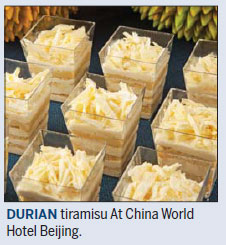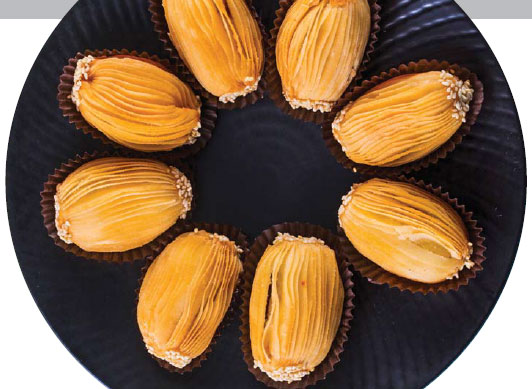Stinky fruit scent from heaven
Updated: 2016-11-04 07:25
By Pauline D Loh(China Daily Europe)
|
|||||||||
Editor's note: To understand China, sit down to eat. Food is the indestructible bond that holds the social fabric together. It is also one of the last strong bonds of community and culture.
For some, it is an abomination from hell, raising an intolerable stink that is an assault on the senses. To others, it is ambrosia from heaven, nature's gift of the perfect fruit. And now, the durian is finding an increasing following in China, land of a million gourmets.
While plantation owners in Southeast Asia are delirious with delight at this growing trend, their faithful consumers in traditional markets are not so happy.
Because of the demand in China, supplies in both Singapore and its native Malaysia have fallen greatly short, and prices have sky rocketed this year.
|
Flaky durian puffs hide a delicious filling and are immensely popular. Photos Provided to China Daily |
|
Sweetened durian foie gras mousse with osmanthus at Kowloon Shangri-La, Hong Kong. |
Designer varieties like Musang King and D24, especially, have mostly been sent to China, leaving durian lovers in Singapore and Malaysia scrabbling for the limited supply left to them.
"These are special trees that fruit in the equatorial foothills at about 1,000 meters above sea level. They need cooler weather at night to set fruit after pollination by bats, and the best come from Pahang state," says Eric Chew, who shifted his Malaysian durian sales operations to Guangzhou five years ago.
His company sells mainly Malaysian Musang King durians to China and has expanded with more carefully chosen plantation sites in Laos and Vietnam to meet Chinese demands for the fruit.
The most popular products in China are vacuum-packed, flash-frozen Musang King durian, as well as Sudan King and D24 frozen durian pulp, which is suitable for hotel bakeries and professional confectioneries.
Durian Royal Family, Chew's company, is a wholesaler that used to cater to only major clients with minimum orders of container loads. In 2011, China lifted its restrictions on the import of Malaysian durians and demand from smaller retailers boomed.
It is for this section of the market that Chew decided to set up his base in Guangzhou, from where he directly serves clients from Shanghai, Beijing and Guangzhou.
"There are a lot of online sellers in Shanghai, so we do most of our business there. In Beijing, we cater mainly to five-star hotels."
Guangzhou and Hong Kong are established markets, since the Cantonese have been eating and loving durian for a very long time. They believe this nutrient-rich fruit is a natural tonic with recuperative qualities.
Chew says that since 2011, the wholesale price of quality durian in China has risen from 3 Malaysian ringgit (71 cents; 65 euro cents; 58 pence) per kilogram to more than 70 ringgit. The current exchange rate is one ringgit to 1.60 yuan.
The 20-fold increase is still continuing and, because of limited supplies, prices look likely to go up even more. A quick check online shows that Chinese consumers are paying from 400 to 500 yuan for half a large durian, and about 350 on average for a 200g tub of ready-to-eat durian pulp.
Why are the Chinese prepared to pay so much for this prickly, pungent fruit?
Tastewise, you either love it or hate it. Will Ding and his wife, Zhang Ying, are typical converts.
"When we first went to Singapore, we couldn't stand the smell and couldn't understand why people were so enthusiastic about it," says Ding. "Then we took a trip to Penang island in Malaysia and visited a specialty stall.
"The proprietor patiently introduced us to all the varieties - buttery sweet ones, the bittersweet varieties. We were hooked from then on."
The couple compare the experience to wine-tasting.
These days, Ding and Zhang take trips each year to seek out the best durians in season, and the names of designer varietals like Musang King, Sudan King, Red Prawn and D24 roll easily off their tongues.
The proliferation of international five-star hotels with their globalized kitchens has also done its part in introducing this exotic fruit, converting younger consumers in China with seductive durian desserts.
Many executive chefs and food and beverage directors are from Singapore and Malaysia, and they have made efforts to introduce their favorite fruit to their diners.
Many hotels even have special durian promotions in season.
China, it seems, has awakened to the intense pleasures of the King of Fruit and things will never be the same again.
paulined@chinadaily.com.cn
Choosing a good durian
The "fresh" durians we see in supermarkets and fruit stalls abroad are not tree-ripened, and they are all mostly from Thailand or Vietnam. According to Eric Chew, Malaysian varieties must be eaten within three days of harvesting.
Even the most efficient logistics fall short of that time limit, which is why the fruit must be vacuum-packed and flash-frozen to keep it at its best for export.
Never buy a durian that has split. A split durian, no matter what your eager fruit seller says, is an indication that it has already started fermenting.
Fresh durians should be whole, the skin color bright and not matted or dulled. You should be able to open it easily along its natural crack lines. If you have to use too much force, it means the durian was harvested before its time.
Durians, once opened, must be eaten as soon as possible, or carefully wrapped and sealed and frozen immediately.
Depending on your taste preferences, you can decide on which type of durian you like.

Some like their fruit buttery and custard-like, very sweet and less pungent. These varieties have skin that tends to be greenish-yellow. A good example is the Golden Pillow variety from Thailand that is very fleshy but drier and milder in flavor.
Musang King grows in the foothills of Malaysia's Central Range, especially in Pahang around Genting Highlands. This variety is treasured for its fragrance and its soft bittersweet flesh. It has a greenish-gray shell.
The D24 and its varietals have golden yellow flesh and are very full-flavored.
Red Prawn is so named because of its orange-red flesh. However, it does not travel well as the fruit tends to weep soon after opening.
To many durian connoisseurs, though, the best fruits were the little "kampung" durians. These were from wild trees that grew in secondary forests in the countryside - unnamed varieties that are harvested and sold by the sides of roads and highways.
These little fruits may not have pedigrees, but they always taste good. Buying a whole basket and opening each one, not knowing what to expect, was one of the pleasures of durian seasons in the past.
But those days are over and serve only as memories these days as we tuck into durians that are vacuum-packed and flash-frozen.
(China Daily European Weekly 11/04/2016 page18)
Today's Top News
Li promotes SCO bank, free trade
High Court: Parliament must vote before Brexit
Court to instruct how to trigger formal EU exit
Premier emphasizes fight against terror
Italian authorities vow to rebuild earthquake-hit areas
Li arrives in Kyrgyzstan for visit, SCO meeting
Xi affirms one-China policy
France to begin moving migrant minors from Calais
Hot Topics
Lunar probe , China growth forecasts, Emission rules get tougher, China seen through 'colored lens', International board,
Editor's Picks

|

|

|

|

|

|









